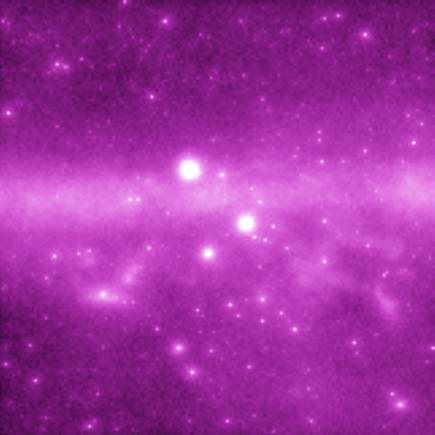Explanation: This simulated image models the intensities of gamma rays with over 40 million times the energy of visible light, and represents how the sky might appear to the proposed Gamma-ray Large Area Space Telescope (GLAST) after its first year in orbit. Familiar steady stars are absent from the dramatic 80x80 degree field which looks directly away from the center of the Galaxy. Instead, the Geminga and Crab pulsars - bizarre, spinning stellar corpses known to be neutron stars - are the two brightest gamma-ray sources. These and other bright objects in the field, dense pulsars, monstrous active galaxies, and still unknown sources, have been detected by the Energetic Gamma-Ray Experiment Telescope (EGRET) on the orbiting Compton Gamma-Ray Observatory. However, most of the simulated point sources are new - extrapolating current ideas and anticipating discoveries resulting from GLAST's improved gamma-ray vision. The central broad band of faint gamma-ray emission is due to high-energy cosmic rays colliding with interstellar gas in the outer spiral arms of the Milky Way, while below is a diffuse energetic glow from prominent molecular clouds in Monoceros, Orion, Auriga, and Taurus. Intended to explore the most extreme energy sources in the distant cosmos and planned for launch in 2005, the GLAST mission is under development by NASA and a collaboration of U. S. and international partners.
1999 2000 2001 2002 2003 2004 2005 2006 2007 2008 2009 2010 2011 2012 2013 2014 2015 2016 2017 2018 2019 2020 2021 2022 2023 2024 2025 |
Yanvar' Fevral' Mart Aprel' Mai Iyun' Iyul' Avgust Sentyabr' Oktyabr' Noyabr' Dekabr' |
NASA Web Site Statements, Warnings, and Disclaimers
NASA Official: Jay Norris. Specific rights apply.
A service of: LHEA at NASA / GSFC
& Michigan Tech. U.
|
Publikacii s klyuchevymi slovami:
pulsar - GLAST - gamma ray - gamma-izluchenie - gamma-astronomiya - kosmicheskaya observatoriya im. Komptona
Publikacii so slovami: pulsar - GLAST - gamma ray - gamma-izluchenie - gamma-astronomiya - kosmicheskaya observatoriya im. Komptona | |
Sm. takzhe:
Vse publikacii na tu zhe temu >> | |
